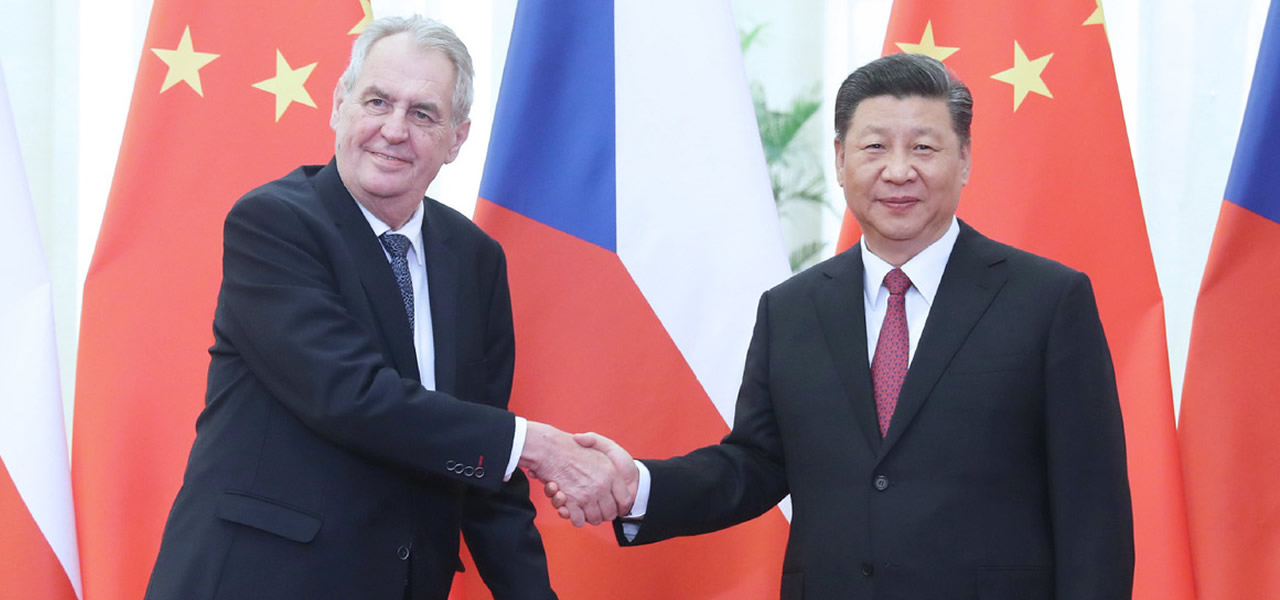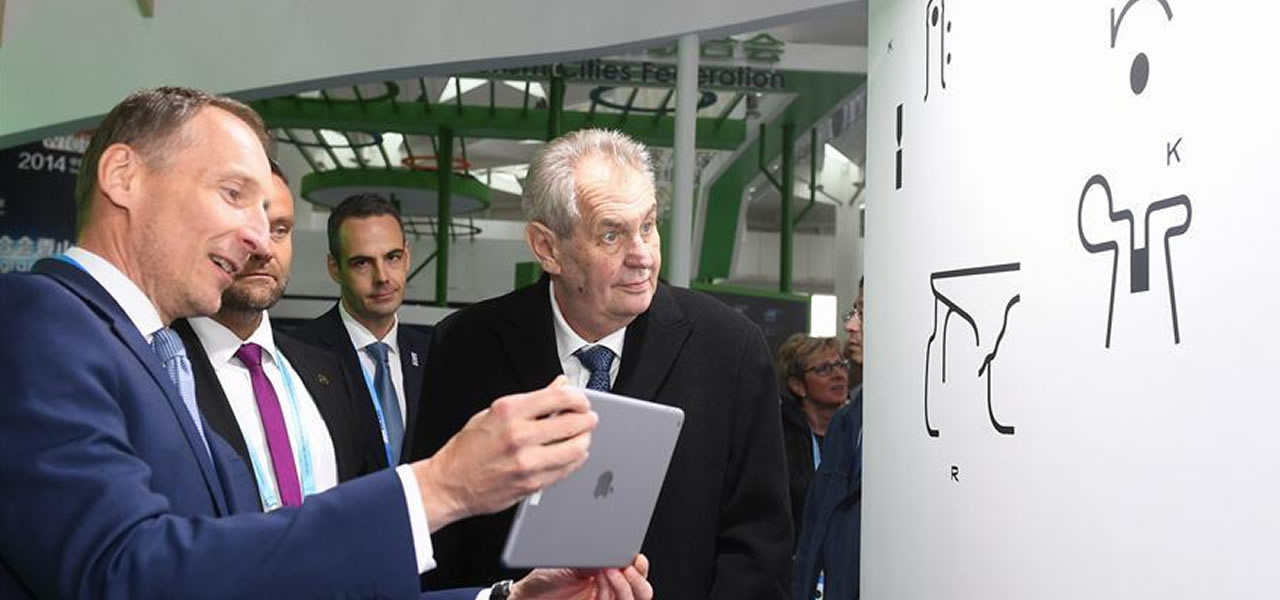President Xi Jinping meets with Czech President Milos Zeman in Beijing, April 28, 2019. [Photo/Xinhua]


President Xi Jinping meets with Czech President Milos Zeman in Beijing, April 28, 2019. [Photo/Xinhua]

Czech President Milos Zeman visits the Czech Republic booth at the International Pavilion of the International Horticultural Exhibition 2019 Beijing, in Beijing, April 28, 2019. [Photo/Xinhua]

China Esteran Airlines
Thanks to the Belt and Road Initiative (BRI), China and the Czech Republic are more connected than ever, resulting in accelerated progress in exchanges and cooperation.
Chinese President Xi Jinping’s historic state visit in March 2016 led to two sides upgrading their bilateral relationship to the level of a strategic partnership. And since then, China and the Czech Republic have enhanced strategic trust, deepened pragmatic cooperation and expanded people-to-people exchanges. Therefore, results have been produced in various fields.
For one thing, bilateral trade has kept increasing. It has exceeded $10 billion for four years in a row. And it reached $16.3 billion in 2018, up by 30.6 percent over the previous year.
China is now the second-biggest trading partner of the Czech Republic, while the latter is China’s second-biggest trading partner in the Central and Eastern European region.
For many Czech companies including Home Credit and Skoda Auto, China is their most important market. One in every four cars produced by Skoda is sold in China.
Last November, President Zeman led a big delegation comprising over 60 Czech companies to Shanghai for the first China International Import Expo. As a result, numerous trade and business agreements were signed.
Bilateral investment has also grown steadily.
According to Chinese statistics, total cumulative agreed investment stood at about $3 billion at the end of 2018, a 10-fold increase from the figure of 2013.
Czech investment in China reached about $300 million by the end of 2018.
From China’s side, A123 Systems, a manufacturer of advanced lithium-ion batteries, established its first operation in Europe in 2017 as it opened a new production facility in Ostrava.
And Yanfeng Automotive Interiors, a global leader in automotive interior solutions, has set up two factories in Zatec and Plana with more than 1,500 employees.
Separately, Bank of China, the Industrial and Commercial Bank of China and Bank of Communications have all set up branches in Prague, facilitating Czech efforts to turn Prague into a financial center serving Central and Eastern Europe.
Travel between China and the Czech Republic has now become much easier with four direct flights linking Prague with Beijing, Shanghai, Chengdu and Xi’an.
Prague International Airport received over 190,000 passengers from China in 2018. And Chinese tourists totaled 620,000 in 2018, making China the biggest source of foreign tourists outside the European Union for the Czech Republic. There are also two freight train services from China to Prague and Pardubice. Also, Chinese companies have set up more overseas warehouses and logistics centers in Prague. And cross-border e-commerce now enjoys robust growth.
Cultural exchanges are also flourishing.
A “Happy Spring Festival” gala performance, a Chinese Movie Week and joint production of films and TV dramas have promoted mutual understanding between the two peoples. And there has also been more cooperation in sports, especially in football and ice hockey.
Retired footballer Pavel Nedved and ice hockey player Jaromir Jagr are actively involved as ambassadors of goodwill. And as China is to host the Winter Olympic Games in 2022, we may expect even more cooperation in winter sports in particular.
In the medical field, the first center of traditional Chinese medicine in the Central and Eastern European region was set up in the Czech Republic in 2015. And now more Czech patients are interested in treatment and care from the East.
Tong Ren Tang, a leading producer of traditional Chinese medicine, now runs a clinic in Prague. And its services are covered by VZP, one of the biggest Czech medical insurance providers.
All these are just a few examples of what the Belt and Road Initiative has brought to China-Czech cooperation.
Since President Xi proposed the initiative in 2013, it has become important that China contributes to global cooperation for common development. And featuring the principle of consultation and cooperation for shared benefit and the vision of green, clean and sustainable development, the Belt and Road cooperation has been increasingly welcomed as a joint endeavor in pursuit of peace, prosperity, openness, innovation and cultural exchange for all participants.
Given its location at the heart of Europe and along the Silk Road Economic Belt, the Czech Republic has a big role to play in the Belt and Road cooperation.
President Zeman will attend the second Belt and Road Forum for International Cooperation in Beijing. And it will be a good opportunity for both sides to further expand converging interests, unleash the potential for bilateral cooperation and strengthen practical cooperation to the benefit of both peoples.
The Czech Republic was among the first to recognize the People’s Republic of China in 1949. And as we celebrate the 70th anniversary of our diplomatic ties this year, we need to build on the strength of this traditional friendship and keep pace with the times to enhance cooperation.
Efforts should be made to promote greater synergy in our development strategies. And we must draw on each other’s strength to step up cooperation in the automotive industry, aviation, machinery, energy and other sectors as well as in the high-tech fields of nanotechnology, laser, digital technology, medicine and biotechnology.
Through the platform of the international import expo, China is prepared to buy more from the Czech Republic and reduce the trade imbalance.
The prospects of cooperation are also bright in tourism, culture, health, education, people-to-people links and sub-national exchanges.
Amid growing uncertainty in the world about trade ties, both countries are resolute in opposing unilateralism and protectionism. And both countries are ready to strengthen dialogue and coordination on major international issues and remain committed to working together under the framework of 16+1 cooperation to boost cooperation not just between Central and Eastern European countries and China, but also between the EU and China.
President Xi and President Zeman planted a sapling of a Chinese Ginkgo tree together in 2016 when President Xi visited Prague. When President Zeman visited Beijing two years earlier, he gave the Chinese president a sapling of a Czech apple tree. Both trees are considered as symbols of the China-Czech friendship and cooperation.
A Czech saying goes that without work there are no kolaches. Similarly, it is necessary for both sides to make joint efforts in order for the trees of friendship and cooperation to bear more fruit. Opportunities are ahead of us, and it is up to us to seize them and work for even greater progress in mutually beneficial cooperation.
by Zhang Jianmin
 Former Czech President Vaclav Klaus, together with Czech Ambassador to China Vladimir Tomsik and Czech Philharmonic General Manager Robert Hanc, visit the Memorial Hall of the Victims of the Nanjing Massacre and pay tribute to the 300,000 victims, Jiangsu province. [Photo provided to chinadaily.com.cn]
Former Czech President Vaclav Klaus, together with Czech Ambassador to China Vladimir Tomsik and Czech Philharmonic General Manager Robert Hanc, visit the Memorial Hall of the Victims of the Nanjing Massacre and pay tribute to the 300,000 victims, Jiangsu province. [Photo provided to chinadaily.com.cn]
For the 70th anniversary of the start of China-Czech diplomatic relations, the Czech Philharmonic, one of the world’s top orchestras, kicked off its 2019 China concert tour in Nanjing on Saturday.
The orchestra held its first performance in China at the Jiangsu Art Center, and many famous performers were included in the roster. The orchestra’s Nanjing program was conducted by renowned Czech conductor Petr Altrichter, who was named Voice of the Czech Republic and My Country respectively over the two nights of the weekend.
As a delightful surprise for the China tour, the orchestra will work with the Jiangsu Symphony Orchestra to play My Country, the Chinese song of the same name composed by Liu Chi.
Former Czech President Vaclav Klaus said, “The Czech Philharmonic can serve as a great ambassador of Czech culture and I am happy it can be presented to Chinese audiences. I am very glad for its cooperation with Nanjing.”
The former president, together with Czech Ambassador to China Vladimir Tomsik and Czech Philharmonic General Manager Robert Hanc, visited the Memorial Hall of the Victims of the Nanjing Massacre and took part in a flower-laying ceremony in memory of the 300,000 victims.
A Nanjing delegation has been invited to visit the Lidice Holocaust Memorial and the site of the Terezin Nazi Concentration Camp in the Czech Republic.
“The Czech Republic and China are both countries that faced similar struggles during World War II,” Tomsik said. “We have strived for peace and peaceful cooperation. Through the universal language of music, different races, nations and countries can connect to build a community with a better and brighter future for mankind.
“I believe endeavors like the Czech Philharmonic’s tour of China can strengthen bonds of friendship between countries and their peoples. We can build a more prosperous future together.”
The Czech Philharmonic Orchestra also signed a memorandum of cooperation with Jiangsu province to form a strategic partnership with the city of Nanjing for the next five years.
According to the memorandum, the two sides will strengthen cooperation in music performances, music festivals, artist exchanges and art education.
Beginning this year, the Czech Philharmonic will send their musicians to China yearly for both educational and performance purposes. Musicians from the Jiangsu Symphony will be invited to participate in cultural exchange projects in Prague.
“We are excited to share Czech history and culture through classical music,” Hanc said.. “Since music is the most beautiful, borderless and universal language, we firmly believe music can become a very important means of communication between the Czech and Chinese people.
“Through music we can further enhance our mutual understanding.”